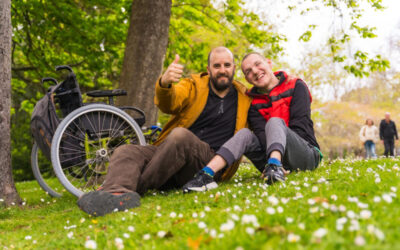When a child doesn’t meet developmental milestones — like talking, walking, or interacting with others — it’s natural for parents and carers to wonder why. Two terms that often come up in this context are Global Developmental Delay (GDD) and Autism Spectrum Disorder (ASD). While these conditions can appear similar in young children, they’re not the same, and understanding the difference is key to providing the proper support at the right time. It’s important to remember that child development is unique for every individual, and babies and children progress at their own pace.
At Bloom Healthcare, we work with children and families every day who are navigating both GDD and autism. Our team of speech pathologists, occupational therapists, psychologists, and behaviour support practitioners are here to help with early identification, therapeutic support, and NDIS guidance — tailored to each child’s needs. We offer a comprehensive range of assessments and support services to address the diverse needs of children with GDD and autism.
What Is Global Developmental Delay (GDD)?
Global Developmental Delay is a diagnosis typically given to children under the age of 5 who show significant delays in two or more areas of development. Delayed development in these areas often prompts assessment for GDD. These areas might include:
- Speech and language
- Motor skills (fine or gross)
- Cognitive ability (thinking, learning, problem-solving)
- Social and emotional skills
- Daily living activities
Importantly, GDD is not a lifelong diagnosis. It’s often used in early childhood when a child is clearly behind in their development, but a more specific diagnosis (like autism or intellectual disability) can’t yet be confirmed. Monitoring a child’s development over time is crucial for determining if a more specific diagnosis is necessary.
Some children with GDD go on to catch up with their peers; others may later receive a more specific diagnosis as they grow.
What Is Autism Spectrum Disorder (ASD)?
Autism is a neurodevelopmental condition that affects how a person communicates, interacts, and experiences the world. Autism is lifelong and presents across a spectrum — meaning no two people with autism are exactly the same.
Core characteristics of autism include:
- Differences in social communication (e.g. understanding body language, making conversation)
- Repetitive behaviours or intense interests
- Sensory sensitivities
- A preference for routines or predictability
- Differences in eye contact
- Delays or differences in language skills
Individuals with autism may experience difficulty with social communication and adapting to societal expectations, which can impact daily functioning and development.
Unlike GDD, autism can often be diagnosed beyond age 2 or 3, once consistent patterns of behaviour and early signs are identified. The process of obtaining an autism diagnosis typically involves initial screening, recognition of early signs such as differences in eye contact or language skills, and a specialist evaluation based on diagnostic criteria like those in the DSM-5-TR. Diagnosis may be made by a paediatrician, psychologist, or multidisciplinary team.
Developmental Screening and Early Childhood
Developmental screening is a vital first step in understanding your child’s growth and identifying any potential developmental delays or concerns, including autism spectrum disorder. These screenings involve simple questions and observations that help healthcare professionals assess your child’s cognitive skills, language development, social skills, and emotional wellbeing.
Early intervention services can make a significant difference for children who show signs of developmental delays or are diagnosed with a spectrum disorder. Services such as Occupational Therapy, Speech Therapy, and Physical Therapy are designed to support children in building essential skills for daily living, communication, and social interaction. A developmental pediatrician can guide families through this process, helping to create a personalised plan that addresses each child’s unique strengths and challenges.
Genetic factors play an important role in a child’s development. Genetic testing can help identify certain genetic disorders, such as Fragile X syndrome or tuberous sclerosis, which are associated with an increased risk of developmental delays and autism spectrum disorder. Environmental factors, including exposure to certain medications or health conditions during pregnancy, can also influence a child’s risk for developmental disabilities.
Some children may experience rare conditions like childhood disintegrative disorder, which involves a significant loss of language, social, and cognitive skills after a period of typical development. Intellectual disability, which often co-occurs with autism spectrum disorder, is characterised by challenges in cognitive and adaptive functioning.
Occupational therapists are key members of the early intervention team, helping children develop the skills needed for daily living—such as dressing, feeding, and using the bathroom—and supporting them in managing sensory sensitivities to loud noises or certain textures. Early intervention also focuses on developing social skills, such as sharing, turn-taking, and understanding social cues, which are essential for successful interactions with other children.
Autism symptoms can vary widely, but may include difficulties with social interaction, communication challenges, and repetitive behaviours such as hand flapping or repeating words. Sensory sensitivities, like being overwhelmed by loud noises or refusing certain foods or fabrics, are also common. The CDC estimates that autism spectrum disorder affects about 1 in 36 children, with boys at a higher risk than girls. Many children with autism also experience co-occurring conditions, such as ADHD or anxiety, which can further impact their development.
Key Differences Between GDD and Autism
While GDD and autism can both involve delays, they differ in scope, duration, and characteristics. Identifying risk factors and considering other conditions are important when assessing a child’s development, as these can influence how professionals diagnose and support each child’s unique needs.
| Feature | Global Developmental Delay | Autism Spectrum Disorder |
|---|---|---|
| Age of diagnosis | Typically under age 5 (diagnosed through developmental screening and evaluation) | Usually age 2+, but can be later (diagnosed by observing behaviour and meeting specific criteria) |
| Development areas affected | Two or more domains (e.g. speech + motor) | Primarily social communication + behaviours |
| Communication | May be delayed broadly | Often atypical (e.g. echolalia, non-verbal cues) |
| Social engagement | May be immature or limited | Often marked differences in reciprocity |
| Repetitive behaviours | Not typical | Common and can be intense |
| Diagnosis duration | Sometimes temporary or transitional | Lifelong neurodevelopmental condition |
Some children have both GDD and autism, which is why comprehensive assessment and support tailored to each child’s profile are essential.
How Bloom Healthcare Supports Children with GDD or Autism
At Bloom Healthcare, we recognise that every child develops at a unique pace. Whether your child has GDD, autism, or both, our allied health professionals deliver individualised, NDIS-funded support to help your child build confidence, communication, and independence. We offer evidence-based treatment and a range of therapies, including those tailored to each child’s specific needs, with a focus on early intervention and proven strategies to support skill development.
Speech Pathology
- Supports children with delayed speech, language, or social communication
- Helps children with autism express themselves and understand others
Learn more about Bloom Speech Pathology
Occupational Therapy
- Builds fine and gross motor skills in children with GDD
- Supports sensory processing and emotional regulation in children with autism
Explore Occupational Therapy at Bloom
Psychology
- Supports emotional wellbeing, behavioural challenges, and social skills
- Provides diagnosis and support strategies for autism
Bloom Psychology & Counselling
Positive Behaviour Support
- Helps reduce behaviours of concern by understanding their root causes
- Builds alternative skills in both children with autism and GDD
See our PBS services
All therapies are coordinated with families, educators, and support teams to ensure consistency across settings and alignment with each child’s NDIS plan.
When Should You Seek Assessment or Support?
You might consider speaking to a GP or allied health professional if your child:
- Is not meeting key developmental milestones
- Struggles to communicate wants or needs
- Appears overwhelmed in busy or sensory environments
- Has trouble with play, turn-taking, or emotional regulation
- Shows repetitive behaviours or limited interests
- Is struggling to engage in childcare, kindergarten, or school settings
The earlier you seek support, the more we can do to promote your child’s growth and wellbeing.
NDIS and Access to Therapy for GDD or Autism
Both GDD and autism can be supported under the NDIS Early Childhood Approach for children aged 0–6. After age 7, children with a diagnosis of autism or developmental disability may be eligible for ongoing support under an individual NDIS plan.
At Bloom Healthcare, we:
- Provide therapy reports and assessments for NDIS access
- Align goals with functional outcomes for better funding alignment
- Work with Early Childhood Partners and support coordinators to streamline care
Need help navigating the NDIS for your child? We’re here for that too.
While Global Developmental Delay and Autism Spectrum Disorder can sometimes look similar, they are distinct in how they affect a child’s development and in what kind of supports they require. GDD may be a temporary or transitional diagnosis, while autism is lifelong and presents more specific social and behavioural characteristics.
Autistic people are unique individuals with a wide range of strengths and abilities, and autism is a neurological difference that is present from birth. Certain genetic and environmental factors, such as parental age or prenatal exposures, can put some children at greater risk for developing autism. The experiences and challenges faced by autistic people often differ from those of neurotypical people, especially since societal expectations are typically designed for neurotypical people.
At Bloom Healthcare, we don’t just treat a diagnosis — we support the whole child. Our multidisciplinary team works closely with families to create tailored therapy plans that meet children where they are and help them grow with confidence.
Ongoing research is essential for deepening our understanding and improving support for children with GDD and autism.
Because every child deserves the proper support to thrive.




